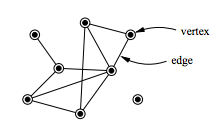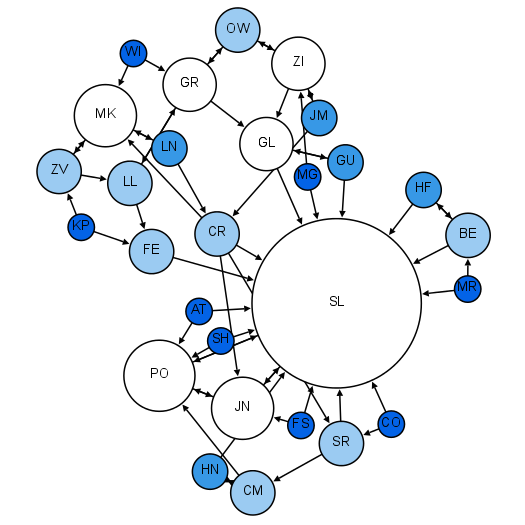|
Assortative Mixing
In the study of complex networks, assortative mixing, or assortativity, is a bias in favor of connections between network nodes with similar characteristics. In the specific case of social networks, assortative mixing is also known as homophily. The rarer disassortative mixing is a bias in favor of connections between dissimilar nodes. In social networks, for example, individuals commonly choose to associate with others of similar age, nationality, location, race, income, educational level, religion, or language as themselves. In networks of sexual contact, the same biases are observed, but mixing is also disassortative by gender – most partnerships are between individuals of opposite sex. Assortative mixing can have effects, for example, on the spread of disease: if individuals have contact primarily with other members of the same population groups, then diseases will spread primarily within those groups. Many diseases are indeed known to have differing prevalence in d ... [...More Info...] [...Related Items...] OR: [Wikipedia] [Google] [Baidu] |
Social Networks
A social network is a social structure consisting of a set of social actors (such as individuals or organizations), networks of dyadic ties, and other social interactions between actors. The social network perspective provides a set of methods for analyzing the structure of whole social entities along with a variety of theories explaining the patterns observed in these structures. The study of these structures uses social network analysis to identify local and global patterns, locate influential entities, and examine dynamics of networks. For instance, social network analysis has been used in studying the spread of misinformation on social media platforms or analyzing the influence of key figures in social networks. Social networks and the analysis of them is an inherently interdisciplinary academic field which emerged from social psychology, sociology, statistics, and graph theory. Georg Simmel authored early structural theories in sociology emphasizing the dynamics of tria ... [...More Info...] [...Related Items...] OR: [Wikipedia] [Google] [Baidu] |
Social Science Methodology
Social organisms, including human(s), live collectively in interacting populations. This interaction is considered social whether they are aware of it or not, and whether the exchange is voluntary or not. Etymology The word "social" derives from the Latin word ''socii'' ("allies"). It is particularly derived from the Italian ''Socii'' states, historical allies of the Roman Republic (although they rebelled against Rome in the Social War of 91–87 BC). Social theorists In the view of Karl Marx,Morrison, Ken. ''Marx, Durkheim, Weber. Formations of modern social thought'' human beings are intrinsically, necessarily and by definition social beings who, beyond being "gregarious creatures", cannot survive and meet their needs other than through social co-operation and association. Their social characteristics are therefore to a large extent an objectively given fact, stamped on them from birth and affirmed by socialization processes; and, according to Marx, in producing and reproduci ... [...More Info...] [...Related Items...] OR: [Wikipedia] [Google] [Baidu] |
Network Theory
In mathematics, computer science, and network science, network theory is a part of graph theory. It defines networks as Graph (discrete mathematics), graphs where the vertices or edges possess attributes. Network theory analyses these networks over the symmetric relations or directed graph, asymmetric relations between their (discrete) components. Network theory has applications in many disciplines, including statistical physics, particle physics, computer science, electrical engineering, biology, archaeology, linguistics, economics, finance, operations research, climatology, ecology, public health, sociology, psychology, and neuroscience. Applications of network theory include Logistics, logistical networks, the World Wide Web, Internet, gene regulatory networks, metabolic networks, social networks, epistemological networks, etc.; see List of network theory topics for more examples. Euler's solution of the Seven Bridges of Königsberg, Seven Bridges of Königsberg problem is c ... [...More Info...] [...Related Items...] OR: [Wikipedia] [Google] [Baidu] |
Preferential Attachment
A preferential attachment process is any of a class of processes in which some quantity, typically some form of wealth or credit, is distributed among a number of individuals or objects according to how much they already have, so that those who are already wealthy receive more than those who are not. "Preferential attachment" is only the most recent of many names that have been given to such processes. They are also referred to under the names Yule process, cumulative advantage, the rich get richer, and the Matthew effect. They are also related to Gibrat's law. The principal reason for scientific interest in preferential attachment is that it can, under suitable circumstances, generate power law distributions. If preferential attachment is non-linear, measured distributions may deviate from a power law. These mechanisms may generate distributions which are approximately power law over transient periods. Definition A preferential attachment process is a stochastic urn p ... [...More Info...] [...Related Items...] OR: [Wikipedia] [Google] [Baidu] |
Homophily
Homophily () is a concept in sociology describing the tendency of individuals to associate and bond with similar others, as in the proverb "". The presence of homophily has been discovered in a vast array of network studies: over have observed homophily in some form or another, and they establish that similarity is associated with connection. The categories on which homophily occurs include age, gender, class, and organizational role. The opposite of homophily is heterophily or intermingling. Individuals in homophilic relationships share common characteristics (beliefs, values, education, etc.) that make communication and relationship formation easier. Homophily between mated pairs in animals has been extensively studied in the field of evolutionary biology, where it is known as '' assortative mating''. Homophily between mated pairs is common within natural animal mating populations. Homophily has a variety of consequences for social and economic outcomes. Types and dimen ... [...More Info...] [...Related Items...] OR: [Wikipedia] [Google] [Baidu] |
Heterophily
Heterophily (meaning "love of the different") is the tendency of individuals to collect in diverse groups; it is the opposite of ''homophily''. This phenomenon can be seen in relationships between individuals. As a result, it can be analyzed in the workplace to create a more efficient and innovative workplace. It has also become an area of social network analysis. Origin and definition of the term Most of the early work in heterophily was done in the 1960s by Everett Rogers in his book ''Diffusion Of Innovations''. According to Rogers, "Heterophily, the mirror opposite of homophily, is defined as the degree to which pairs of individuals who interact are different in certain attributes". This is in contrast to homophily, the likelihood that individuals are to surround themselves with those they share similarities with. An example of heterophily would be to individuals from different ethnic and socio-economic backgrounds becoming friends. Through his work Rogers showed that heterophil ... [...More Info...] [...Related Items...] OR: [Wikipedia] [Google] [Baidu] |
Graph Theory
In mathematics and computer science, graph theory is the study of ''graph (discrete mathematics), graphs'', which are mathematical structures used to model pairwise relations between objects. A graph in this context is made up of ''Vertex (graph theory), vertices'' (also called ''nodes'' or ''points'') which are connected by ''Glossary of graph theory terms#edge, edges'' (also called ''arcs'', ''links'' or ''lines''). A distinction is made between undirected graphs, where edges link two vertices symmetrically, and directed graphs, where edges link two vertices asymmetrically. Graphs are one of the principal objects of study in discrete mathematics. Definitions Definitions in graph theory vary. The following are some of the more basic ways of defining graphs and related mathematical structures. Graph In one restricted but very common sense of the term, a graph is an ordered pair G=(V,E) comprising: * V, a Set (mathematics), set of vertices (also called nodes or points); * ... [...More Info...] [...Related Items...] OR: [Wikipedia] [Google] [Baidu] |
Friendship Paradox
The friendship paradox is the phenomenon first observed by the sociologist Scott L. Feld in 1991 that on average, an individual's friends have more friends than that individual. It can be explained as a form of sampling bias in which people with more friends are more likely to be in one's own friend group. In other words, one is less likely to be friends with someone who has very few friends. In contradiction to this, most people believe that they have more friends than their friends have. The same observation can be applied more generally to social networks defined by other relations than friendship: for instance, most people's sexual partners have had (on the average) a greater number of sexual partners than they have. The friendship paradox is an example of how network structure can significantly distort an individual's local observations. Mathematical explanation In spite of its apparently paradoxical nature, the phenomenon is real, and can be explained as a consequence of ... [...More Info...] [...Related Items...] OR: [Wikipedia] [Google] [Baidu] |
Assortativity
Assortativity, or assortative mixing, is a preference for a network's nodes to attach to others that are similar in some way. Though the specific measure of similarity may vary, network theorists often examine assortativity in terms of a node's degree. The addition of this characteristic to network models more closely approximates the behaviors of many real world networks. Correlations between nodes of similar degree are often found in the mixing patterns of many observable networks. For instance, in social networks, nodes tend to be connected with other nodes with similar degree values. This tendency is referred to as assortative mixing, or ''assortativity''. On the other hand, technological and biological networks typically show disassortative mixing, or ''disassortativity'', as high degree nodes tend to attach to low degree nodes. Measurement Assortativity is often operationalized as a correlation between two nodes. However, there are several ways to capture such a corr ... [...More Info...] [...Related Items...] OR: [Wikipedia] [Google] [Baidu] |



